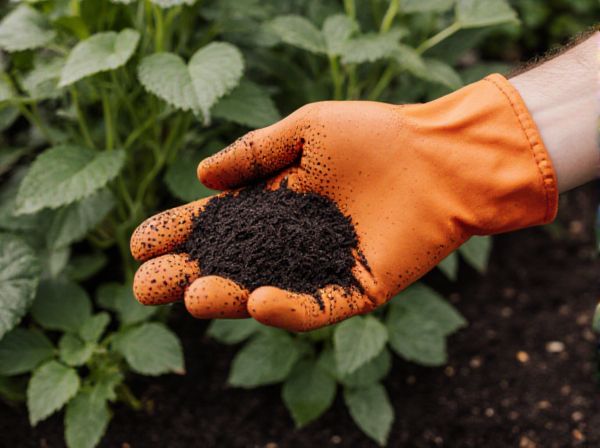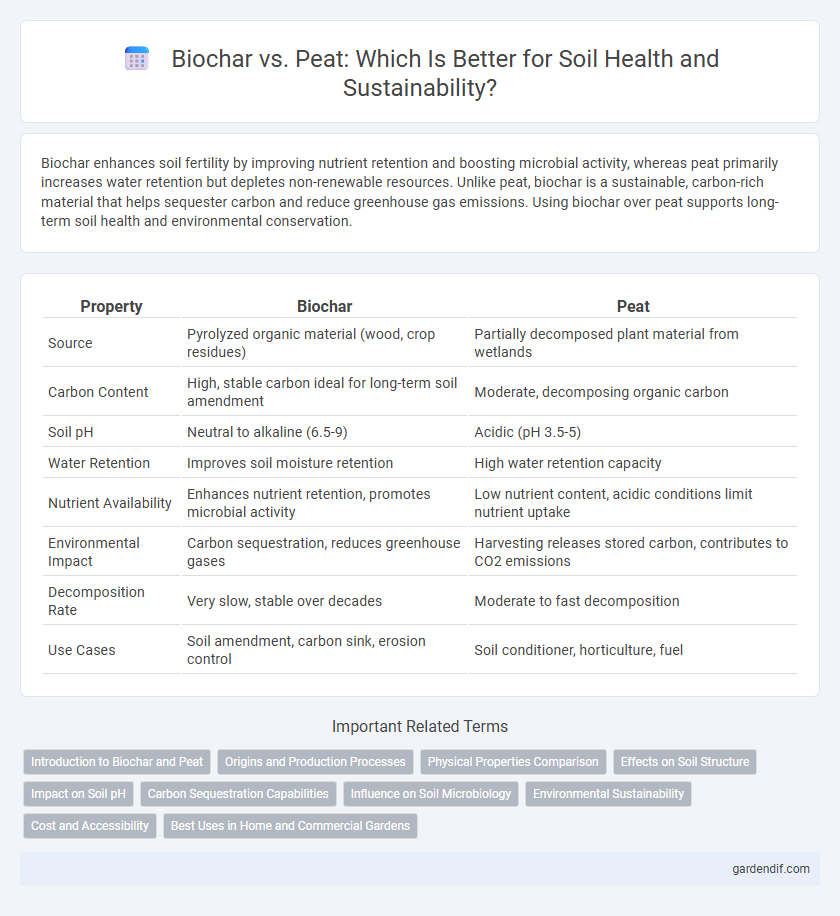
Biochar vs Peat Illustration
Biochar enhances soil fertility by improving nutrient retention and boosting microbial activity, whereas peat primarily increases water retention but depletes non-renewable resources. Unlike peat, biochar is a sustainable, carbon-rich material that helps sequester carbon and reduce greenhouse gas emissions. Using biochar over peat supports long-term soil health and environmental conservation.
Table of Comparison
| Property | Biochar | Peat |
|---|---|---|
| Source | Pyrolyzed organic material (wood, crop residues) | Partially decomposed plant material from wetlands |
| Carbon Content | High, stable carbon ideal for long-term soil amendment | Moderate, decomposing organic carbon |
| Soil pH | Neutral to alkaline (6.5-9) | Acidic (pH 3.5-5) |
| Water Retention | Improves soil moisture retention | High water retention capacity |
| Nutrient Availability | Enhances nutrient retention, promotes microbial activity | Low nutrient content, acidic conditions limit nutrient uptake |
| Environmental Impact | Carbon sequestration, reduces greenhouse gases | Harvesting releases stored carbon, contributes to CO2 emissions |
| Decomposition Rate | Very slow, stable over decades | Moderate to fast decomposition |
| Use Cases | Soil amendment, carbon sink, erosion control | Soil conditioner, horticulture, fuel |
Introduction to Biochar and Peat
Biochar is a stable, carbon-rich material produced through the pyrolysis of organic biomass, widely used to enhance soil fertility and sequester carbon. Peat consists of accumulated partially decayed organic matter found in wetlands, commonly utilized as a soil amendment for its water retention and nutrient content. While biochar improves soil structure and nutrient availability through its porous nature, peat mainly contributes to moisture retention but poses sustainability concerns due to its slow regeneration.
Origins and Production Processes
Biochar is produced through the pyrolysis of organic biomass such as agricultural residues, forestry waste, and manure, involving thermal decomposition in a low-oxygen environment. Peat forms naturally over thousands of years from partially decayed plant material in waterlogged, anaerobic conditions, commonly found in peat bogs and wetlands. The production of biochar is a controlled, industrial process aimed at enhancing soil carbon retention, whereas peat extraction is a slow, natural accumulation process often associated with ecological disturbance and carbon release.
Physical Properties Comparison
Biochar exhibits higher porosity and surface area compared to peat, enhancing soil aeration and water retention capacity. Its improved structural stability reduces compaction risks, promoting better root growth and microbial activity. In contrast, peat's lower bulk density and moisture-holding capacity make it less effective for long-term soil physical improvement.
Effects on Soil Structure
Biochar enhances soil structure by increasing porosity and improving aeration, which promotes root growth and water retention. Peat, while rich in organic matter, tends to compact over time, reducing soil permeability and limiting aeration. Incorporating biochar into soil improves aggregation and microbial activity more effectively than peat, resulting in sustained soil health and fertility.
Impact on Soil pH
Biochar typically raises soil pH by increasing alkalinity, benefiting acidic soils by neutralizing excess acidity and improving nutrient availability. Peat, conversely, tends to lower soil pH due to its naturally acidic composition, which can be advantageous for acid-loving plants but may exacerbate acidity in neutral or alkaline soils. Choosing between biochar and peat depends on the desired pH adjustment and specific crop requirements.
Carbon Sequestration Capabilities
Biochar exhibits superior carbon sequestration capabilities compared to peat due to its stable carbon structure that remains in the soil for centuries, effectively reducing atmospheric CO2 levels. Peat stores carbon but is prone to decomposition and oxidation when disturbed, releasing stored carbon back into the atmosphere. Utilizing biochar in soil enhances long-term carbon storage and promotes soil fertility, making it a more sustainable option for carbon management.
Influence on Soil Microbiology
Biochar improves soil microbiology by increasing microbial diversity and stimulating beneficial bacteria that enhance nutrient cycling and soil fertility. In contrast, peat tends to suppress microbial activity due to its high acidity and low nutrient availability, resulting in slower decomposition and reduced microbial biomass. The porous structure of biochar provides habitat for microbes, promoting healthier soil ecosystems compared to the compact nature of peat.
Environmental Sustainability
Biochar improves soil fertility while sequestering carbon, reducing greenhouse gas emissions more effectively than peat, whose extraction releases stored carbon and damages peatland ecosystems. Unlike peat, biochar is a renewable resource produced from agricultural waste, promoting circular economy practices. Implementing biochar in soil management supports long-term environmental sustainability by enhancing soil health and mitigating climate change impacts.
Cost and Accessibility
Biochar offers a cost-effective and sustainable alternative to peat, with prices generally lower due to its production from agricultural waste. Peat extraction often involves higher expenses and regulatory restrictions, limiting accessibility in many regions. Biochar's increasing availability supports large-scale soil amendment projects, making it a practical choice for improving soil health while reducing environmental impact.
Best Uses in Home and Commercial Gardens
Biochar enhances soil fertility by improving nutrient retention and supporting beneficial microbial activity, making it ideal for both home vegetable gardens and commercial farming operations. Peat provides excellent water retention and acidity regulation, suitable for acid-loving plants and seed starting in home gardens, but its commercial use raises environmental concerns due to slow renewal rates. Combining biochar with compost or peat can optimize soil structure and nutrient availability for diverse gardening needs.
Biochar vs Peat Infographic

 gardendif.com
gardendif.com